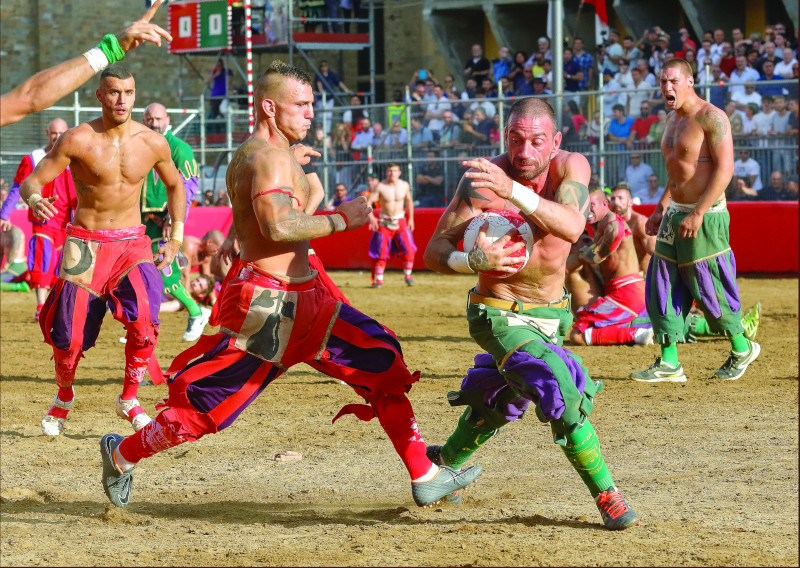Every summer in Florence, Piazza Santa Croce turns into a bloodbath. Calcio storico, the brutal, medieval Italian sport that inspired modern American football, rugby and even hockey, has players literally fighting each other on the pitch, while spectators cheer on their favourite team from the sides. No game is without blood spill.
Too small to be a real war and too cruel to be a game.
King Henry III of France

1. History
The game is a 2,000-year-old Florence tradition, Director of Calcio Storico, Luciano Artusi, explains in Netflix’s Home Game. “In 59 BC, when Roman legionnaires founded the colony of Florentia, they would play to keep fit.” The game as it is played today however dates back to the end of the 15th century and beginning of the 16th century. At that time, only the elites were playing. Rich aristocrats and nobleman held a game every night between Epiphany and Lent.
One of the first documented games was played on 17 February 1530, in defiance of the imperial troops sent by Charles V, as the city was under siege. The “noble game” was played in Piazza Santa Croce, only by distinguished soldiers, lords, noblemen and princes. In 1574, a game was put on in honour of King Henry III of France, while he was visiting Venice. After attending the game, he famously described it as “too small to be a real war and too cruel to be a game”.
2. The rules
The rules of calcio storico were first officially published by Giovanni de’ Bardi in 1580 and not much has changed since.
It’s like rugby, but with no rules.
Calciante

Two teams play against each other in one game. The pitch is 100 by 50 metres, split in two squares. Nets are placed along the short edges of the court. The aim is to place the ball in the other team’s net, scoring a caccia, one point. But if a player, called calciante, throws the ball and misses, the opposing team gets half a point. The game lasts 50 minutes and the team with the most points, cacce, wins.
There are four teams in the tournament, representing the historic neighbourhoods of Florence: Rossi (the reds), from Santa Maria Novella, Verdi (the greens), from San Giovanni, Azzuri (the blues), from Santa Croce, and Bianchi (the whites), from Santo Spirito. Traditionally, you have to be born in that neighbourhood to be allowed to play in its team, but the rules were changed a few years ago to allow for two outside players to be brought into each team.

Teams are formed of 27 players, goalkeepers, defenders and strikers, all wearing traditional costumes. While in other sports fights are incidents, in calcio storico, fighting is a ball movement strategy. There are 12 players on the outside trying to score, while the 15 in the middle are clearing the path for them, by any means necessary, including punching, kicking and throwing, everything is allowed.
Once a player is on the ground, he is not allowed to get up until a goal is scored. Moreover, if a player is eliminated or injured badly enough to not be able to play anymore, there are no replacements, so the sooner they are brought down the better.
The hardest part of calcio storico is playing 2 games within 10 days. You almost certainly won’t play the final with the same team from the semi-final because the players won’t recover in time.
Raffaele D’Eligio, Calciante for Bianchi

There is one tournament each year, with 2 semi-finals and one final. The games are played in Piazza Santa Croce, in front of the church of the same name. Sand and dirt are brought onto the square to form the pitch and bleachers are placed on each side for spectators. There are 9 days between the semi-finals and the final, to give players some time to recover, with the latter always being played on 24 June, on the day of St John the Baptist, the patron saint of Florence, at 5 pm.
Between the two events, players are surrounded by doctors who try to fix as much of the damage as possible. Broken bones, cracked heads, missing teeth, in a game with “no rules”, any injury is possible. It is not uncommon to see players with bloody faces by the end of the game, but, maybe surprisingly considering the sport’s brutality, there are no registered deaths from calcio storico.

Unlike other sports, where players make careers, calcio storico players have regular jobs. A few days before the tournament begins, when training gets more intensive, they take days off work. The amount of leave they need then depends on how badly they get injured during the game. Despite all the apparent downsides, they are proud to be a calciante, some even encouraging and preparing their sons to take over the tradition.
The prize? Glory. The winning team traditionally receives a cow that gets turned into dinner. Nowadays, after being paraded around, the white Chianina calf just returns to its stall and players have dinner at a restaurant. There is no trophy, there are no money, the winning team and the neighbourhood it comes from get the honour and glory of beating out the others.












